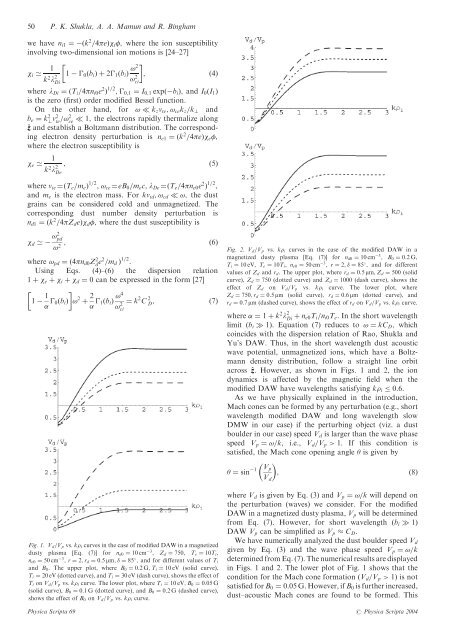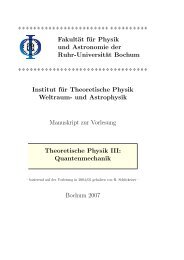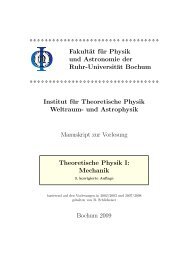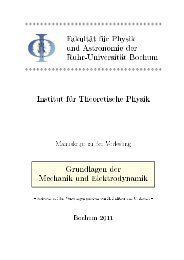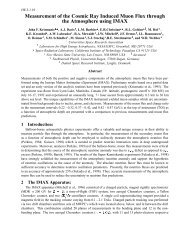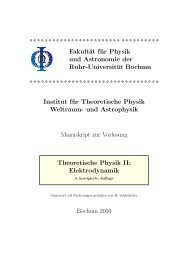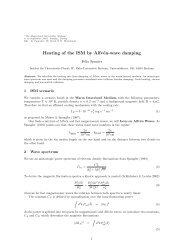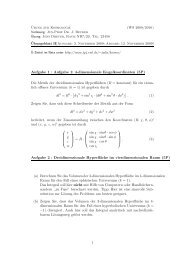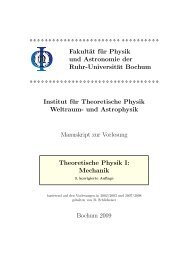PDF FILE - Theoretische Physik IV
PDF FILE - Theoretische Physik IV
PDF FILE - Theoretische Physik IV
You also want an ePaper? Increase the reach of your titles
YUMPU automatically turns print PDFs into web optimized ePapers that Google loves.
50 P. K. Shukla, A. A. Mamun and R. Bingham<br />
we have n i1 ¼ ðk 2 =4eÞ i ; where the ion susceptibility<br />
involving two-dimensional ion motions is [24–27]<br />
i ’ 1 <br />
<br />
k 2 l 2 1 0ðb i Þþ2 1 ðb i Þ !2<br />
! 2 ; ð4Þ<br />
Di<br />
ci<br />
where l Di ¼ðT i =4n i0 e 2 Þ 1=2 ; 0;1 ¼ I 0;1 expð b i Þ; and I 0 ðI 1 Þ<br />
is the zero (first) order modified Bessel function.<br />
On the other hand, for ! k z v te ;! ce k z =k ? and<br />
b e ¼ k 2 ? v2 te =!2 ce 1; the electrons rapidly thermalize along<br />
^z and establish a Boltzmann distribution. The corresponding<br />
electron density perturbation is n e1 ¼ðk 2 =4eÞ e ;<br />
where the electron susceptibility is<br />
e ’ 1<br />
k 2 l 2 ; ð5Þ<br />
De<br />
where v te ¼ðT e =m e Þ 1=2 , ! ce ¼eB 0 =m e c, l De ¼ðT e =4n e0 e 2 Þ 1=2 ;<br />
and m e is the electron mass. For kv td ;! cd !; the dust<br />
grains can be considered cold and unmagnetized. The<br />
corresponding dust number density perturbation is<br />
n d1 ¼ðk 2 =4Z d eÞ d ; where the dust susceptibility is<br />
d ’<br />
!2 pd<br />
! 2 ; ð6Þ<br />
Fig. 2. V d =V p vs. k i curves in the case of the modified DAW in a<br />
where ! pd ¼ð4n d0 Z 2 d e2 =m d Þ 1=2 magnetized dusty plasma [Eq. (7)] for n d0 ¼ 10 cm<br />
:<br />
, B 0 ¼ 0:2 G,<br />
T i ¼ 10 eV, T e ¼ 10T i , n e0 ¼ 50 cm 3 , r ¼ 2;¼ 85 ; and for different<br />
Using Eqs. (4)–(6) the dispersion relation values of Z d and r d : The upper plot, where r d ¼ 0:5 mm; Z d ¼ 500 (solid<br />
1 þ e þ i þ d ¼ 0 can be expressed in the form [27] curve), Z d ¼ 750 (dotted curve) and Z d ¼ 1000 (dash curve), shows the<br />
1<br />
effect of Z d on V d =V p vs. k i curve. The lower plot, where<br />
1<br />
<br />
0 ðb i Þ<br />
! 2 ¼ k 2 C 2 D ; ð7Þ Z d ¼ 750; r d ¼ 0:5 mm (solid curve), r d ¼ 0:6 mm (dotted curve), and<br />
r d ¼ 0:7 mm (dashed curve), shows the effect of r d on V d =V p vs. k i curve.<br />
ci<br />
where ¼ 1 þ k 2 l 2 Di þ n e0T i =n i0 T e : In the short wavelength<br />
limit ðb i 1Þ: Equation (7) reduces to ! ¼ kC D ; which<br />
coincides with the dispersion relation of Rao, Shukla and<br />
Yu’s DAW. Thus, in the short wavelength dust acoustic<br />
wave potential, unmagnetized ions, which have a Boltzmann<br />
density distribution, follow a straight line orbit<br />
across ^z: However, as shown in Figs. 1 and 2, the ion<br />
dynamics is affected by the magnetic field when the<br />
modified DAW have wavelengths satisfying k i 0:6:<br />
As we have physically explained in the introduction,<br />
Mach cones can be formed by any perturbation (e.g., short<br />
wavelength modified DAW and long wavelength slow<br />
DMW in our case) if the perturbing object (viz. a dust<br />
boulder in our case) speed V d is larger than the wave phase<br />
speed V p ¼ !=k; i.e., V d =V p > 1: If this condition is<br />
satisfied, the Mach cone opening angle is given by<br />
<br />
¼ sin 1 V p<br />
;<br />
V d<br />
ð8Þ<br />
Fig. 1. V d =V p vs. k i curves in the case of modified DAW in a magnetized<br />
dusty plasma [Eq. (7)] for n d0 ¼ 10 cm 3 , Z d ¼ 750, T e ¼ 10T i ,<br />
n e0 ¼ 50 cm 3 , r ¼ 2; r d ¼ 0:5 mm;¼ 85 ; and for different values of T i<br />
and B 0 : The upper plot, where B 0 ¼ 0:2 G; T i ¼ 10 eV (solid curve),<br />
T i ¼ 20 eV (dotted curve), and T i ¼ 30 eV (dash curve), shows the effect of<br />
T i on V d =V p vs. k i curve. The lower plot, where T i ¼ 10 eV; B 0 ¼ 0:05 G<br />
(solid curve), B 0 ¼ 0:1 G (dotted curve), and B 0 ¼ 0:2 G (dashed curve),<br />
shows the effect of B 0 on V d =V p vs. k i curve.<br />
where V d is given by Eq. (3) and V p ¼ !=k will depend on<br />
the perturbation (waves) we consider. For the modified<br />
DAW in a magnetized dusty plasma, V p will be determined<br />
from Eq. (7). However, for short wavelength ðb i 1Þ<br />
DAW V p can be simplified as V p C D :<br />
We have numerically analyzed the dust boulder speed V d<br />
given by Eq. (3) and the wave phase speed V p ¼ !=k<br />
determined from Eq. (7). The numerical results are displayed<br />
in Figs. 1 and 2. The lower plot of Fig. 1 shows that the<br />
condition for the Mach cone formation ðV d =V p > 1Þ is not<br />
satisfied for B 0 ¼ 0:05 G: However, if B 0 is further increased,<br />
dust–acoustic Mach cones are found to be formed. This<br />
Physica Scripta 69 # Physica Scripta 2004


